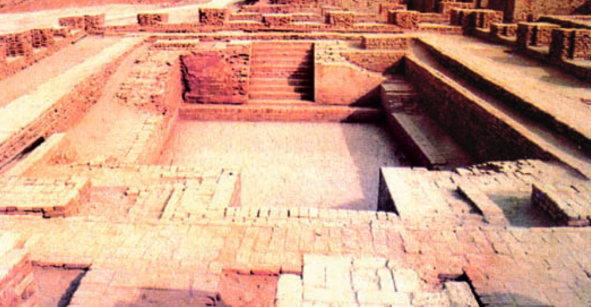The Harappan Civilisation
- Archaeologists discovered Harappa in present day Pakistan and realised that it was one of the oldest cities in the subcontinent.
- All other sites from where similar buildings and other things were found were described as Harappan.
- These cities developed about 4,700 years ago.
- These cities were found in the Punjab and Sind in Pakistan, and in Gujarat, Rajasthan and Haryana and the Punjab in India.
- Archaeologists have found a set of unique objects in almost all these cities: red pottery painted with designs in black, stone weights, seals, special beads, copper tools, and long stone blades.
Read More: Class 6 Ch 3 History-From Gathering to Growing Food
Special Characteristics of these Cities
- Many of them were divided into two or more parts.
- The part to the west was smaller but higher. It has been described as “citadel” by archaeologists.
- The part to the east was larger but lower and is called the lower town.
- Very often walls of baked bricks were built around each part. The bricks were laid in an interlocking pattern and that made the walls strong.
- Generally, houses were either one or two storeys high, with rooms built around a courtyard.
- Most houses had a separate bathing area, and some had wells to supply water.
- They had covered drains laid out in straight lines. Each drain had a gentle slope so that water could flow through it. Very often drains in houses were connected to those on the streets and smaller drains led into bigger ones. Inspection holes were provided at intervals to clean them.
- All three- houses, drains and streets- were probably planned and built at the same time.
Mohenjodaro
- A very special tank called the Great Bath was built on the Citadel.
- It was lined with bricks, coated with plaster, and made water-tight using a layer of natural tar.
- There were steps leading down to it from two sides, and rooms on all sides.
- Perhaps important people took a dip in this tank on special occasions.
Kalibangan & Lothal
- They had fire altars where sacrifices may have been performed.
Mohenjodaro, Harappa and Lothal
- They had elaborate store houses.
Life in a Harappan City
- A Harappan city was a very busy place.
- The rulers (probably) planned the construction of special buildings in the city. It is likely that they sent people to distant lands to get metal, precious stones, and other things that they wanted.
- There were scribes, people who knew how to write, who helped prepare the seals, and perhaps wrote on other materials that have not survived.
- There were men and women, craft persons, making all kinds of things- either in their own homes or in special workshops.
- People travelled to distant lands and returned with raw materials and, perhaps, stories.
- Many terracotta toys have also been found.
Crafts
- Most of the things discovered by archaeologists are made of stone, shell and metal, including copper, bronze, gold and silver.
- Copper and bronze were used to make tools, weapons, ornaments and vessels.
- Gold and silver were used to make ornaments and vessels.
- Beads, weights and blades were important finds.
- Weights were very carefully and precisely shaped. These were made of chert, a kind of stone and were probably used to weigh precious stones or metals.
- Many beads were made out of carnelian, a beautiful red stone.
- They also made seals out of stone which were generally rectangular and had an animal carved on them.
- They also made pots with beautiful black designs.
- A stone statue of an important man found from Mohenjodaro shows him wearing an embroidered garment.
- Actual pieces of cloth were found attached to the lid of a silver vase and some copper objects at Mohenjodaro.
- Spindle whorls, made of terracotta and faience were used to spin thread.
What is Faience?
- Unlike stone or shell, that are found naturally, faience is a material produced artificially.
- A gum was used to shape sand or powdered quartz into an object.
- The objects were then glazed, resulting in a shiny, glassy surface.
- The colours of the glaze were usually blue or sea green.
- Faience was used to make beads, bangles, earrings, and tiny vessels.
In Search of Raw Materials
- Some of the raw materials that they used were available locally, many items had to be brought from distant places.
- Copper was brought from present-day Rajasthan and Oman.
- Tin (Tin+Copper= Bronze) was brought from present day Afghanistan and Iran.
- Gold- present day Karnataka.
- Precious Stones- present day Gujarat, Iran and Afghanistan.
Food
- Farmers and herders living in the countryside supplied food to craftspersons, scribes and rulers in the cities.
- They grew wheat, barley, pulses, peas, rice, sesame, linseed and mustard.
- The plough was used to dig the earth for turning the soil and planting seeds.
Harappan Towns in Gujarat
Dholavira
- It was located on Khadir Beyt in the Rann of Kutch and had fresh water and fertile soil.
- Unlike other cities, it was divided into three parts. Each part was surrounded by massive stone walls, with entrances through gateways.
- There was a large open area where public ceremonies could be held.
- Large letters of the Harappan script carved out of white stone and perhaps inlaid in wood were discovered. This is a unique find as generally Harappan writing has been found on small objects such as seals.
Lothal
- It stood beside a tributary of the Sabarmati, in Gujarat, close to the Gulf of Khambhat.
- It was situated near areas where raw materials such as semi-precious stones were easily available.
- It was an important centre for making objects out of stone, shell and metal.
- There was also a storehouse in the city.
- Many seals and sealings (the impression of seals on clay) were found in this storehouse.
- It had a huge tank which may have been a dockyard, where boats and ships came in from the sea and through the river channel. Goods were probably loaded and unloaded here.
- A building, probably a workshop for making beads has also been found here.
What are Seals and Sealings?
- Seals may have been used to stamp bags or packets containing goods that were sent from one place to another.
- After a bag was closed or tied, a layer of wet clay was applied on the knot, and the seal was pressed on it.
- The impression of the seal is known as a sealing.
- If the sealing was intact, one could be sure that the goods had arrived safely.
Possible Reasons of the Mysterious End of the Civilisation
- The rivers dried up.
- Deforestation. This could have happened because fuel was required for baking bricks, and for smelting copper ores.
- Overgrazing by large herds of cattle may have destroyed the green cover.
- Floods.
- The rulers lost control.
- The beginning of the end of these cities began around 3900 years ago.











